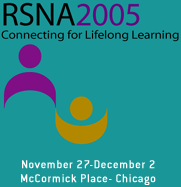
Abstract Archives of the RSNA, 2005
SSE01-03
Evaluation of Mammographic Findings after Intraoperative Radiation (IORT) Alone for Early Stage Breast Cancer
Scientific Papers
Presented on November 28, 2005
Presented as part of SSE01: Breast (Mammography)
Sean Dermot Curran MBBCh, Presenter: Nothing to Disclose
Anuradha Khilnani MD, Abstract Co-Author: Nothing to Disclose
Micheal Zelefsky MD, Abstract Co-Author: Nothing to Disclose
Virgilio Sacchini MD, Abstract Co-Author: Nothing to Disclose
Lee K Tan MD, Abstract Co-Author: Nothing to Disclose
Beryl McCormick MD, Abstract Co-Author: Nothing to Disclose
Elizabeth Anne Morris MD, Abstract Co-Author: Nothing to Disclose
et al, Abstract Co-Author: Nothing to Disclose
IORT is a promising treatment option for patients who are undergoing breast conservation, and may obviate the need for external beam radiation. The purpose is to evaluate the mammographic findings following single dose Intraoperative Radiation Therapy (IORT) without external beam radiation for early stage Breast cancer.
Thirty seven patients received IORT between March 2003 and June 2004. The pre- and post IORT mammograms of 20 of 37 patients (age range: 45-84; mean 71.9) were retrospectively reviewed with consensus by two dedicated Breast imagers. Follow-up ranged from 6 months to 24 months (mean 13 months). All patients had invasive ductal carcinoma (IDC: n=15), invasive lobular carcinoma (ILC: n=3) or mixed IDC/ILC (n=2). All patients had sentinel lymph node biopsy which was negative for metastatic disease. All tumors were less than 2 cm (mean size 0.98 cm; range 0.2-1.9 cm). 7/22 (32%) of cancers showed malignant microcalcifications on preoperative mammograms. Each patient received a single session intraoperative radiation dose of 20 Gy using a H.A.M. (Harrison-Anderson-Mick; Mick Radio-nuclear instruments, Mount Vernon, NY, USA) silastic applicator. Pathologic specimens of 5 patients biopsied post IORT for suspected recurrence were reviewed and correlated with the mammographic findings.
All patients had multiple punctate "pseudocalcifications" at the lumpectomy site. Five patients were biopsied post IORT yielding benign results with multiple angular densities causing a foreign body reaction in each case on histological examination. Pathologically these densities are much denser than normal calcifications and further composition analysis was carried out. Other mammographic findings included 1/20 (5%) with skin thickening, 2/20 (9%) showed new or increased dystrophic calcifications/fat necrosis and 10/20 (50%) had a hematoma/seroma (mean size 4.8 cm; range 2-7 cm) cavity post IORT.
All of the 20 patients with post IORT follow-up mammography demonstrated punctate "pseudo-calcifications" at the surgical bed yielding benign findings. Therefore, these "pseudo-calcifications" should not be considered recurrent disease, and unnecessary biopsies should be avoided.
Curran, S,
Khilnani, A,
Zelefsky, M,
Sacchini, V,
Tan, L,
McCormick, B,
Morris, E,
et al, ,
Evaluation of Mammographic Findings after Intraoperative Radiation (IORT) Alone for Early Stage Breast Cancer. Radiological Society of North America 2005 Scientific Assembly and Annual Meeting, November 27 - December 2, 2005 ,Chicago IL.
http://archive.rsna.org/2005/4407750.html

